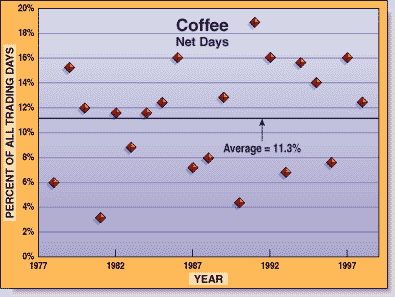TRADING TECHNIQUES
Markets Don't Trend, They Burst
by K.D. Angle
Is there really such a thing as a trend? Maybe not. Maybe a relatively few pops in price make up most of the market movement we see.
Does this statement, or something like it, sound familiar? "Of the annual returns from the stock market over the last 10 years, 90% were generated in a month or so, and unless you're always in the market, you'll miss out on those few days that generate the vast majority of returns."

FIGURE 1: COFFEE, DAYS OF MOVEMENT. When you count the days that actually led to new highs and new lows, you'll find that, in most markets, only about 12% of trading days contribute to net price movement, up or down. For coffee, it was 11.3%.
Variations of that statement are common, and it's true that an "always in the market" strategy has worked for portfolio managers like Warren Buffett as well as large commodity/futures money managers that utilize long-term trend-following strategies. Stepping back and taking a look at a 10-year chart of the daily prices of the Dow Jones Industrial Average (DJIA) would certainly give an observer the impression that this has been a long-term trending bull market. Even if you examined a monthly chart over the last few decades, you would come up with a similar conclusion. But if you were to analyze the movement of daily net vertical price movement, you would begin to understand that there was something altogether different taking place.
As a market timer, I wanted to know if market prices really tended to move in bursts, something that generally favors the "in the market all the time" approach. I wanted to answer the following questions:
1 Out of roughly 250 trading days in a calendar year, how many trading days contributed to generating all of the net vertical price movement during the course of a calendar year?
2 If the net vertical price movement were generated from a particularly small number of trading days, is this phenomenon unique to the stock market, or does it occur in other markets as well?
THE BURST EFFECT
First, I looked at a 10-year history of the current bull stock market and determined how many trading days generated most of the vertical price movement each year. My research confirmed that 80% of the gains made in the stock market have been generated in about three trading days on average per calendar year. Unlike many other markets, however, the stock market has been pretty much a straightforward affair for many years.
Most other markets such as Treasury bonds, crude oil, and foreign currencies have not experienced a decade-long bull market the way the stock market has. In most other markets, sometimes the trend is up, and sometimes the trend is down. So rather than using a 10-year period in evaluating those markets that do not concern stocks, I looked at each market and defined the direction of the trend in terms of calendar-year periods.
Kelly Angle, CTA, is president of K.D. Angle & Co. He can be reached at 203 972-1776, his Website at www.kellyangle.com, or via E-mail at inquiry@kellyangle.com.
Excerpted from an article originally published in the December 1999 issue of Technical Analysis of STOCKS & COMMODITIES magazine. All rights reserved. © Copyright 1999, Technical Analysis, Inc.
Return to December 1999 Contents